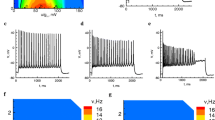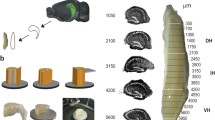Summary
Intracellular recordings were made from hippocampal pyramidal cells identified by their depths and their responses to commissural stimulation. Recordings were made during spontaneous bouts of hippocampal theta rhythm in urethane anesthetized rats. Membrane potentials (V m) of pyramidal cells varied with the phase of the theta rhythm, that is, there was an “intracellular theta rhythm”. The changes in V m averaged about 2 mV peak to peak. Averaged intracellular theta waves showed that CA1 pyramids were most depolarized at the time of the positive peak of the extracellular theta rhythm recorded in (and superficial to) the CA1 pyramidal cell layer (CA1 theta). Peak depolarizations for CA3/4 pyramids were more broadly distributed, but occurred mainly in the interval just before the positive peak to just before the negative peak of the CA1 theta. Input impedance minima that were measurable at frequencies as high as 100 Hz occurred at about the same phases of the extracellular theta rhythm as the peak depolarizations (positive-going zero crossing to negative-going zero crossing of the CA1 theta). Such impedance changes imply conductance changes on the soma. The magnitude and localization of the conductance changes suggests that somatic IPSPs make major contributions to the intracellular theta rhythm. The phase relation between the intracellular and extracellular theta rhythms could be reversed by long duration current pulses that depolarized the cells slightly. This implies that either the intracellular theta-related IPSPs are depolarizing potential changes, or that they occur simultaneously with EPSPs. The phase of the intracellular theta rhythm was generally unaffected by long duration hyperpolarizing current pulses. Chloride leakage that reversed the evoked IPSPs usually had no effect on the phase of the intracellular theta rhythm, although in one case it appeared to cause its amplitude to increase.
Similar content being viewed by others
References
Alger BE, Nicoll RA (1982) Pharmacological evidence for two kinds of GABA receptor on rat hippocampal pyramidal cells studied in vitro. J Physiol (Lond) 328:125–141
Andersen P, Dingledine R, Gjerstad L, Langmoen IA, Mosfeldt-Laursen A (1980) Two different responses of hippocampal pyramidal cells to application of gamma-amino butyric acid. J Physiol (Lond) 305:279–296
Andersen P, Eccles JC, Løyning Y (1964a) Location of postsynaptic inhibitory synapses on hippocampal pyramids. J Neurophysiol 27:592–607
Andersen P, Eccles JC, Løyning Y (1964b) Pathway of postsynaptic inhibition in the hippocampus. J Neurophysiol 27:608–619
Artemenko DP (1972) Role of hippocampal neurons in thetawave generation. Neurophysiology 4:409–415
Batschelet E (1981) Circular statistics in biology. Academic Press New York
Bland BH, Andersen P, Ganes T (1975) Two generators of hippocampal theta activity in rabbits. Brain Res 94:199–218
Bland BH, Andersen P, Ganes T, Sveen O (1979) Automated analysis of rhythmicity of physiologically identified hippocampal formation neurons. Exp Brain Res 38:205–219
Bland BH, Whishaw IQ (1976) Generators and topography of hippocampal theta (RSA) in the anesthetized and freely moving rat. Brain Res 118:259–280
Brankačk J, Fox SE (1987) Current sources for the alternating and sustained potentials of the hippocampal theta rhythms of the rat. Soc Neurosci Abstr 13:1331
Buzsaki G, Czopf J, Kondakor I, Kellenyi L (1986) Laminar distribution of hippocampal rhythmic slow activity (RSA) in the behaving rat: current-source density analysis, effects of urethane and atropine. Brain Res 365:125–137
Buzsaki G, Leung LS, Vanderwolf CH (1983) Cellular bases of hippocampal EEG in the behaving rat. Brain Res Rev 6: 139–171
Eccles JC, Nicoll RA, Oshima T, Rubia FJ (1977) The anionic permeability of the inhibitory postsynaptic membrane of hippocampal pyramidal cells. Proc R Soc Lond B 198:345–361
Fox SE (1982) Solutions to three capacitance problems in intracellular single-electrode bridge amplifiers. IEEE Trans Biomed Eng 29:662–666
Fox SE (1985) Location of membrane conductance changes by analysis of the input impedance of neurons. I. Theory. J Neurophysiol 54:1578–1593
Fox SE, Chan CY (1985) Location of membrane conductance changes by analysis of the input impedance of neurons. II. Implementation. J Neurophysiol 54:1594–1606
Fox SE, Stewart M (1986) Analysis of hippocampal theta rhythm shows that correct location of current sources and sinks generating EEG patterns can require DC recording. Soc Neurosci Abstr 12:1527
Fox SE, Wolfson S, Ranck JB Jr (1983) Investigating the mechanisms of hippocampal theta rhythms: approaches and progress. In: Seifert W (ed) Neurobiology of the hippocampus. Academic Press, London, pp. 303–319
Fox SE, Wolfson S, Ranck JB Jr (1986) Hippocampal theta rhythm and the firing of neurons in walking and urethane anesthetized rats. Exp Brain Res 62:495–508
Fujita Y, Sato T (1964) Intracellular records from hippocampal pyramidal cells in rabbit during theta rhythm activity. J Neurophysiol 27:1011–1025
Gogolák G, Stumpf Ch, Petsche H, Šterc J (1968) The firing pattern of septal neurons and the form of the hippocampal theta wave. Brain Res 7:201–207 1968
Green JD, Maxwell DS, Schindler WJ, Stumpf CH (1960) Rabbit EEG “theta” rhythm: its anatomical source and relation to activity in single neurons. J Neurophysiol 23:403–420
Green KF, Rawlins JNP (1979) Hippocampal theta in rats under urethane: generators and phase relations. EEG Clin Neurophysiol 47:420–429
Kandel ER, Spencer WA, Brinley FJ Jr (1961) Electrophysiology of hippocampal neurons. I. Sequential invasion and synaptic organization. J Neurophysiol 24:225–242
Lebeda FJ, Hablitz JJ, Johnston D (1982) Antagonism of GABA-mediated responses by d-tubocurarine in hippocampal neurons. J Neurophysiol 48:622–632
Leung LS, Lopes da Silva FH, Wadman WJ (1982) Spectral characteristics of the hippocampal EEG in the freely moving rat. Electroenceph Clin Neurophysiol 54:203–219
Leung LS, Yim CY (1986) Intracellular records of theta rhythm in hippocampal CA1 cells of the rat. Brain Res 367:323–327
Misgeld U, Deisz RA, Dodt HU, Luz HD (1986) The role of chloride transport in postsynaptic inhibition of hippocampal neurons. Science 232:1413–1415
Nuñez A, García-Austt E, Buño W Jr (1987) Intracellular thetarhythm generation in identified hippocampal pyramids. Brain Res 416:289–300
Pellegrino LJ, Cushman AJ (1967) A stereotaxic atlas of the rat brain. Appleton-Century-Crofts, New York
Petsche H, Stumpf Ch, Gogolák G (1962) The significance of the rabbit's septum as a relay station between the midbrain and the hippocampus. I. The control of the hippocampus arousal activity by the septum cells. EEG Clin Neurophysiol 14:202–211
Rudell AP, Fox SE (1984) Hippocampal excitability related to the phase of the theta rhythm in urethanized rats. Brain Res 294:350–353
Smith TG, Wuerker RB and Frank K (1967) Membrane impedance changes during synaptic transmission in cat spinal motoneurons. J Neurophysiol 30:1072–1096
Vanderwolf CH (1975) Neocortical and hippocampal activation in relation to behavior: effects of atropine, eserine, phenothiazines, and amphetamine. J Comp Physiol Psychol 88:300–323
Vanderwolf CH, Baker GB (1986) Evidence that serotonin mediates non-cholinergic neocortical low voltage fast activity, non-cholinergic hippocampal rhythmical slow activity and contributes to intelligent behavior. Brain Res 374:342–356
Winson J (1974) Patterns of hippocampal theta rhythm in the freely moving rat. EEG Clin Neurophysiol 26:291–301
Winson J (1976a) Hippocampal theta rhythm. I. Depth profiles in the curarized rat. Brain Res 103:57–70
Winson J (1976b) Hippocampal theta rhythm. I. Depth profiles in the freely moving rabbit. Brain Res 103:71–79
Author information
Authors and Affiliations
Rights and permissions
About this article
Cite this article
Fox, S.E. Membrane potential and impedance changes in hippocampal pyramidal cells during theta rhythm. Exp Brain Res 77, 283–294 (1989). https://doi.org/10.1007/BF00274985
Received:
Accepted:
Issue Date:
DOI: https://doi.org/10.1007/BF00274985




